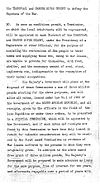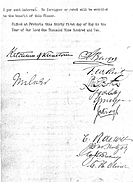| Context | End of the Second Boer War and defeat of the Boer Republics |
|---|---|
| Signed | 31 May 1902 |
| Location | Melrose House, Pretoria, Transvaal Colony (Negotiated in Vereeniging, Transvaal Colony) |
| Signatories |
|
| Parties |
|
| Language | English |
|
| |
The Treaty of Vereeniging (commonly referred to as Peace of Vereeniging)[1] was the peace treaty, signed on 31 May 1902, that ended the Second Boer War between the South African Republic and the Republic of the Orange Free State, on the one side, and the British Empire on the other.
This settlement provided for the end of hostilities and eventual self-government to the Transvaal (South African Republic) and the Orange Free State as colonies of the British Empire. The Boer republics agreed to come under the sovereignty of the British Crown and the British government agreed on various details.
Terms of the settlement[]
This settlement entailed the end of hostilities and the surrender of all Boer forces and their arms to the British, with the promise of eventual self-government to the Transvaal (South African Republic) and the Orange Free State as colonies of the British Empire. The Boer Republics agreed to come under the sovereignty of the British Crown and the British government agreed on various details including the following:
- All Boer fighters of both republics had to give themselves up
- All combatants would be disarmed
- Everyone had to swear allegiance to the Crown
- No death penalties would be dealt out
- A general amnesty would apply
- The use of Dutch would be allowed in the schools and law courts.
- To eventually give the Transvaal and the Orange Free State self-government (civil government was granted in 1906 and 1907, respectively).[2]
- To avoid discussing the native (Black) enfranchisement issue until self-government had been given.
- To pay the Afrikaners £3,000,000 in reconstruction aid.
- Property rights of Boers would be respected
- No land taxes would be introduced
- Registered private guns would be allowed
Subsequent to the British government giving the Boer colonies self-government, the Union of South Africa was created on 31 May 1910. The Union gained relative independence under the 1926 Imperial Conference and the 1931 Statute of Westminster. The country became a republic in 1961 therefore severing all connections with Great Britain. The country rejoined the Commonwealth in 1994.
Although the treaty is named after the town of Vereeniging in Transvaal, where the peace negotiations took place, the document was actually signed at Melrose House in Pretoria.
Original manuscript[]
See also[]
- History of South Africa
- Military history of South Africa
- Francis William Reitz
- Louis Botha
- Koos de la Rey
- Schalk Willem Burger
- Jan Smuts in the Boer War
References[]
External links[]
| Wikisource has original text related to this article: |
- The Peace Negotiations between the Governments of the South African Republic and the Orange Free State, and the Representatives of the British Government at Project Gutenberg
The original article can be found at Treaty of Vereeniging and the edit history here.



